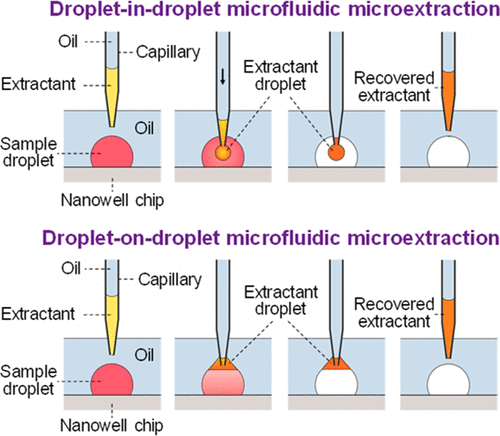当前位置:
X-MOL 学术
›
Anal. Chem.
›
论文详情
Our official English website, www.x-mol.net, welcomes your
feedback! (Note: you will need to create a separate account there.)
Nanoliter-Scale Droplet-Droplet Microfluidic Microextraction Coupled with MALDI-TOF Mass Spectrometry for Metabolite Analysis of Cell Droplets.
Analytical Chemistry ( IF 6.7 ) Pub Date : 2020-06-04 , DOI: 10.1021/acs.analchem.0c00007 Wen-Hua Sun 1 , Yan Wei 2 , Xiao-Li Guo 2 , Qiong Wu 2 , Xin Di 1 , Qun Fang 1, 2
Analytical Chemistry ( IF 6.7 ) Pub Date : 2020-06-04 , DOI: 10.1021/acs.analchem.0c00007 Wen-Hua Sun 1 , Yan Wei 2 , Xiao-Li Guo 2 , Qiong Wu 2 , Xin Di 1 , Qun Fang 1, 2
Affiliation

|
The further miniaturization of liquid-phase microextraction (LPME) systems has important significance and major challenges for microscale sample analysis. Herein, we developed a rapid and flexible droplet–droplet microfluidic microextraction approach to perform nanoliter-scale miniaturized sample pretreatment, by combining droplet-based microfluidics, robotic liquid handling, and LPME techniques. Differing from the previous microextraction methods, both the extractant and sample volumes were decreased from the microliter scale or even milliliter scale to the nanoliter scale. We utilized the ability of a liquid-handling robot to manipulate nanoliter-scale droplets and micrometer-scale positioning to overcome the scaling effect difficulties in performing liquid–liquid extraction of nanoliter-volume samples in microsystems. Two microextraction modes, droplet-in-droplet microfluidic microextraction and droplet-on-droplet microfluidic microextraction, were developed according to the different solubility properties of the extractants. Various factors affecting the microextraction process were investigated, including the extraction time, recovery method of the extractant droplet, static and dynamic extraction mode, and cross-contamination. To demonstrate the validity and adaptability of the pretreatment and analysis of droplet samples with complex matrices, the present microextraction system coupled with MALDI-TOF mass spectrometry (MS) detection was applied to the quantitative determination of 7-ethyl-10-hydroxylcamptothecin (SN-38), an active metabolite of the anticancer drug irinotecan, in 800-nL droplets containing HepG2 cells. A linear relationship (y = 0.0305x + 0.376, R2 = 0.984) was obtained in the range of 4–100 ng/mL, with the limits of detection and quantitation being 2.2 and 4.5 ng/mL for SN-38, respectively.
中文翻译:

纳升级液滴-液滴微流控微萃取与MALDI-TOF质谱联用,用于细胞液滴的代谢物分析。
液相微萃取(LPME)系统的进一步小型化对微型样品分析具有重要意义和重大挑战。在本文中,我们结合了基于液滴的微流控技术,机器人液体处理技术和LPME技术,开发了一种快速灵活的液滴-微流控微萃取方法,以进行纳升级微型样品预处理。与以前的微萃取方法不同,萃取剂和样品的体积都从微升甚至是毫升降到了纳升。我们利用液体处理机器人的能力来操纵纳升级液滴和微米级定位,从而克服了在微系统中对纳升级样品进行液-液萃取时的缩放效应难题。两种微萃取模式,根据萃取剂的不同溶解性,开发了微滴微滴微滴和微滴微滴微滴。研究了影响微萃取过程的各种因素,包括萃取时间,萃取剂液滴的回收方法,静态和动态萃取方式以及交叉污染。为了证明预处理和分析复杂基质的液滴样品的有效性和适应性,本微萃取系统与MALDI-TOF质谱(MS)结合用于定量测定7-乙基-10-羟基喜树碱(SN- 38),一种抗癌药伊立替康的活性代谢产物,在含有HepG2细胞的800-nL液滴中。线性关系(根据萃取剂的不同溶解度特性开发了相应的产品。研究了影响微萃取过程的各种因素,包括萃取时间,萃取剂液滴的回收方法,静态和动态萃取方式以及交叉污染。为了证明预处理和分析复杂基质的液滴样品的有效性和适应性,本微萃取系统与MALDI-TOF质谱(MS)结合用于定量测定7-乙基-10-羟基喜树碱(SN- 38),一种抗癌药伊立替康的活性代谢产物,在含有HepG2细胞的800-nL液滴中。线性关系(根据萃取剂的不同溶解度特性开发了相应的产品。研究了影响微萃取过程的各种因素,包括萃取时间,萃取剂液滴的回收方法,静态和动态萃取方式以及交叉污染。为了证明预处理和分析复杂基质的液滴样品的有效性和适应性,本微萃取系统与MALDI-TOF质谱(MS)结合用于定量测定7-乙基-10-羟基喜树碱(SN- 38),一种抗癌药伊立替康的活性代谢产物,在含有HepG2细胞的800-nL液滴中。线性关系(包括提取时间,提取液滴的回收方法,静态和动态提取方式以及交叉污染。为了证明预处理和分析复杂基质的液滴样品的有效性和适应性,本微萃取系统与MALDI-TOF质谱(MS)结合用于定量测定7-乙基-10-羟基喜树碱(SN- 38),一种抗癌药伊立替康的活性代谢产物,在含有HepG2细胞的800-nL液滴中。线性关系(包括提取时间,提取液滴的回收方法,静态和动态提取方式以及交叉污染。为了证明预处理和分析复杂基质的液滴样品的有效性和适应性,本微萃取系统与MALDI-TOF质谱(MS)结合用于定量测定7-乙基-10-羟基喜树碱(SN- 38),一种抗癌药伊立替康的活性代谢产物,在含有HepG2细胞的800-nL液滴中。线性关系(本微萃取系统结合MALDI-TOF质谱(MS)检测用于定量测定800-nL液滴中的7-乙基-10-羟基喜树碱(SN-38)(抗癌药物伊立替康的活性代谢物)的定量HepG2细胞。线性关系(本微萃取系统结合MALDI-TOF质谱(MS)检测用于定量测定800-nL液滴中的7-乙基-10-羟基喜树碱(SN-38)(抗癌药物伊立替康的活性代谢物)的定量HepG2细胞。线性关系(y = 0.0305 x + 0.376,R 2 = 0.984)在4–100 ng / mL范围内获得,SN-38的检出限和定量限分别为2.2和4.5 ng / mL。
更新日期:2020-07-07
中文翻译:

纳升级液滴-液滴微流控微萃取与MALDI-TOF质谱联用,用于细胞液滴的代谢物分析。
液相微萃取(LPME)系统的进一步小型化对微型样品分析具有重要意义和重大挑战。在本文中,我们结合了基于液滴的微流控技术,机器人液体处理技术和LPME技术,开发了一种快速灵活的液滴-微流控微萃取方法,以进行纳升级微型样品预处理。与以前的微萃取方法不同,萃取剂和样品的体积都从微升甚至是毫升降到了纳升。我们利用液体处理机器人的能力来操纵纳升级液滴和微米级定位,从而克服了在微系统中对纳升级样品进行液-液萃取时的缩放效应难题。两种微萃取模式,根据萃取剂的不同溶解性,开发了微滴微滴微滴和微滴微滴微滴。研究了影响微萃取过程的各种因素,包括萃取时间,萃取剂液滴的回收方法,静态和动态萃取方式以及交叉污染。为了证明预处理和分析复杂基质的液滴样品的有效性和适应性,本微萃取系统与MALDI-TOF质谱(MS)结合用于定量测定7-乙基-10-羟基喜树碱(SN- 38),一种抗癌药伊立替康的活性代谢产物,在含有HepG2细胞的800-nL液滴中。线性关系(根据萃取剂的不同溶解度特性开发了相应的产品。研究了影响微萃取过程的各种因素,包括萃取时间,萃取剂液滴的回收方法,静态和动态萃取方式以及交叉污染。为了证明预处理和分析复杂基质的液滴样品的有效性和适应性,本微萃取系统与MALDI-TOF质谱(MS)结合用于定量测定7-乙基-10-羟基喜树碱(SN- 38),一种抗癌药伊立替康的活性代谢产物,在含有HepG2细胞的800-nL液滴中。线性关系(根据萃取剂的不同溶解度特性开发了相应的产品。研究了影响微萃取过程的各种因素,包括萃取时间,萃取剂液滴的回收方法,静态和动态萃取方式以及交叉污染。为了证明预处理和分析复杂基质的液滴样品的有效性和适应性,本微萃取系统与MALDI-TOF质谱(MS)结合用于定量测定7-乙基-10-羟基喜树碱(SN- 38),一种抗癌药伊立替康的活性代谢产物,在含有HepG2细胞的800-nL液滴中。线性关系(包括提取时间,提取液滴的回收方法,静态和动态提取方式以及交叉污染。为了证明预处理和分析复杂基质的液滴样品的有效性和适应性,本微萃取系统与MALDI-TOF质谱(MS)结合用于定量测定7-乙基-10-羟基喜树碱(SN- 38),一种抗癌药伊立替康的活性代谢产物,在含有HepG2细胞的800-nL液滴中。线性关系(包括提取时间,提取液滴的回收方法,静态和动态提取方式以及交叉污染。为了证明预处理和分析复杂基质的液滴样品的有效性和适应性,本微萃取系统与MALDI-TOF质谱(MS)结合用于定量测定7-乙基-10-羟基喜树碱(SN- 38),一种抗癌药伊立替康的活性代谢产物,在含有HepG2细胞的800-nL液滴中。线性关系(本微萃取系统结合MALDI-TOF质谱(MS)检测用于定量测定800-nL液滴中的7-乙基-10-羟基喜树碱(SN-38)(抗癌药物伊立替康的活性代谢物)的定量HepG2细胞。线性关系(本微萃取系统结合MALDI-TOF质谱(MS)检测用于定量测定800-nL液滴中的7-乙基-10-羟基喜树碱(SN-38)(抗癌药物伊立替康的活性代谢物)的定量HepG2细胞。线性关系(y = 0.0305 x + 0.376,R 2 = 0.984)在4–100 ng / mL范围内获得,SN-38的检出限和定量限分别为2.2和4.5 ng / mL。





















































 京公网安备 11010802027423号
京公网安备 11010802027423号